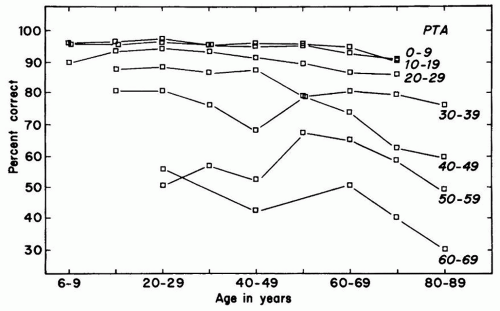Ménière disease |
Episodic attacks of fluctuant SNHL, vertigo, tinnitus, aural fullness or pressure; bilateral in 20%-30% of cases |
History of typical attacks with symptom-free intervals; hearing loss involves low tones initially and later all frequencies, rule out neurosyphilis |
Medical
Diuretics and low-salt diet
Surgical
Decompression or shunt of endolymphatic sac; section of vestibular nerve.
Penicillin and oral steroids |
Luetic hearing loss (late-acquired syphilis) |
Often bilateral SNHL with no characteristic audiometric pattern; speech discrimination score often worse than would be predicted on basis of pure-tone thresholds; often associated with vestibular symptoms; may mimic Ménière disease |
Positive FTA-ABS test, with or without clinical history of syphilis |
Paget disease |
Slowly progressive SNHL and CHL; SNHL worse in high frequencies; maximum CHL of 20-30 dB at 500 Hz |
Skeletal deformities of skull and long bones of extremities, elevated serum alkaline phosphatase and urinary hydroxyproline |
Calcitonin |
Hypothyroidism |
Slowly progressive SNHL affecting all frequencies daily |
Usual clinical stigmata of hypothyroidism; decreased serum T4 |
Desiccated thyroid or Synthroid mixture of T4 and T3 |
Ototoxic drugs |
Hearing loss with or without vestibular dysfunction following treatment with known ototoxic drug |
History |
None |
Hereditary progressive SNHL |
Progressive SNHL beginning at earlier age than expected for presbycusis; possible positive family history |
Family history |
None |
Noise-induced hearing loss |
History of prolonged exposure to loud continuous noise or brief exposure to loud impulse noise |
History; characteristic audiogram with maximum hearing loss at 4,000 Hz; may not be distinguishable from presbycusis |
None; use of ear protectors may prevent further loss from noise exposure |
Head trauma |
Severe head injury often resulting in loss of consciousness and bilateral temporal bone fractures |
History |
None |
Cochlear otosclerosis and far-advanced clinical otosclerosis |
Far-advanced clinical otosclerosis (stapedial fixation) and cochlear otosclerosis; SNHL may appear on audiogram as severe to profound SNHL; patient will have good speech modulation (unlike in profound SNHL) and will be wearing or will have worn a bone conduction hearing aid; possibly a family history of otosclerosis |
History is suggestive but surgical exploration of stapes footplate is diagnostic and therapeutic; poststapedectomy patient may be able to wear ear-level hearing aid with good results |
Stapedectomy, sodium fluoride |
aThe hearing loss from any of these diseases may be improved with hearing aids unless it is of such a degree that hearing aids will be inadequate or unsatisfactory. Individuals with bilateral profound SNHL may be candidates for cochlear implant and should be evaluated by an otologist to determine their suitability for such a device.
SNHL, sensorineural hearing loss; FTA-ABS test, fluorescent treponemal antibody test, CHL, conductive hearing loss; Hz, hertz (cycles per second); dB, decibel (arbitrary unit of sound intensity). |




